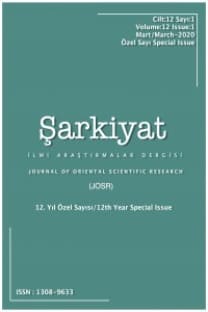NAMAṬ ṢA‘B VE NAMAṬ MUḪÎF
20. yüzyılda klasik Arap şiiri gerek Batı’da gerekse İslam âleminde bazı araştırmacıların iddiaları sonucu güvenilir bir kaynak değeri taşıyıp taşımadığı bakımından çeşitli tartışmalara konu olmuştur. Bu tartışmalara bizzat tanık olan Mahmûd Muhammed Şâkir (öl. 1997), Cahiliye şiirinin aidiyetini gerçek anlamda tespit etmek ve şairlerin edebî kabiliyetlerini saptayabilmek için derin bir okuma sürecine girmiştir. Şâkir, uzun süren bu okuma sürecinden sonra benimsediği tezevvuk metodu sayesinde klasik şiirle ilgili aleyhte iddiaların herhangi bir dayanağı olmadığına kanaat getirmiştir. Bu çalışmada kritiği yapılan Namaṭ ṣa‘b ve namaṭ muḫîf isimli eser, Şâkir’in benimsediği tezevvuk metodunu başarılı bir şekilde yansıtan çalışmaların başında gelmektedir. Şâkir, bu eserinde rivayeti, aidiyeti ve konu bütünlüğü gibi yönlerden tartışmaya açık olan Cahiliye dönemine ait bir kasideyi çok yönlü tahlil etmiştir. Eserde Şâkir; şiir rivayetinin gelişimi, aruzun şiirin anlaşılmasına katkısı, yaşadığı olaylara bağlı olarak şairin yakaladığı ritimler, klasik şerh kültürü, bir metnin nasıl tahlil edileceği gibi birçok meseleye temas etmiştir. Bu çalışmada Şâkir’in belirtilen meselelere nasıl yaklaştığı değerlendirilmiş; ayrıca önemine binaen eserin alandaki araştırmacılar tarafından dikkatli bir şekilde okunması gerektiğinin altı çizilmiştir.
Mahmûd Muhammad Shākir: NAMAṬ ṢA‘B VE NAMAṬ MUḪÎF (Difficult Style and Scary Style)
Classical Arabic poetry has been the subject of various debates in the 20th century as to whether it is a reliable source or not as a result of the claims of some researchers. Mahmûd Muhammad Shākir (d. 1997), who witnessed the debates himself, embarked on a deep reading process, which he called the method of tazawwuq, in order to determine the authenticity of the poetry and the literary value of the poets. After this long reading process, Shākir came to the conclusion that the orientalists' claims about classical poetry had no basis. Namaṭ ṣa‘b ve namaṭ muḫîf, which is evaluated in this study, is one of the works that successfully reflects Shākir's method of tazawwuq. In this work, Shākir analyzed a versatile ode from the Jahiliyyah period, which is open to debate in terms of its narration, attribution and subject integrity. In the work, he touches upon many issues such as the development of poetry narration, the contribution of aruz to the understanding of poetry, the rhythms captured by the poet depending on the events he experienced, the classical commentary culture, and how to analyze a text. This study evaluates how Shākir approaches these issues and underlines that the work should be read carefully by researchers in the field due to its importance.
